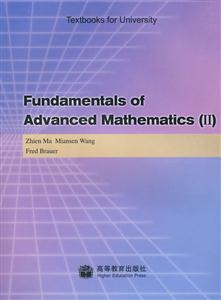高等数学基础(Ⅱ)。2
节选
[
《高等数学基础2(英文版)》讲述了:This is the second volume of the textbook “Fundamentals of Advanced Math-ematics” written by the same authors. It includes vector algebra and analytic geometry in space, multivariable calculus, and linear ordinary differential e-quations. The intentions and features are as introduced in the preface to the first volume. We repeat here the important advice to students in the first vol-ume, as it is equally important for this second volume.In order to learn calculus, it is not enough to read the textbook as if it were a newspaper. Learning requires careful reading, working through exam-ples step by step, and solving problems. Solving problems requires more than imitation of examples. It is necessary to think about what the problem really asks and to develop a method for that particular problem.If something is still not clear after you have tried to understand it, you should ask a classmate, a more advanced student, or your teacher. If a classmate asks you a question, you may learn a great deal from explaining the answer.The following two additional remarks might be helpful to readers in u-sing the second volume.(1) The material on linear systems of ordinary differential equations (Section 9.2) is not included in the fundamental requirements. Before study-ing it, readers will need some basic knowledge of linear algebra.(2) Some of the material in this volume has been stated in terms of ma-trices and determinants. For readers who are not yet familiar with the basic concepts and operations for matrices and determinants we have included a brief outline in Appendix A.
]
内容简介
[
this is the second volume of the textbook “fundamentals of advanced math-ematics” written by the same authors. it includes vector algebra and analytic geometry in space, multivariable calculus, and linear ordinary differential e-quations. the intentions and features are as introduced in the preface to the first volume. we repeat here the important advice to students in the first vol-ume, as it is equally important for this second volume.
in order to learn calculus, it is not enough to read the textbook as if it were a newspaper. learning requires careful reading, working through exam-ples step by step, and solving problems. solving problems requires more than imitation of examples. it is necessary to think about what the problem really asks and to develop a method for that particular problem.
if something is still not clear after you have tried to understand it, you should ask a classmate, a more advanced student, or your teacher. if a classmate asks you a question, you may learn a great deal from explaining the answer.
the following two additional remarks might be helpful to readers in u-sing the second volume.
(1) the material on linear systems of ordinary differential equations (section 9.2) is not included in the fundamental requirements. before study-ing it, readers will need some basic knowledge of linear algebra.
(2) some of the material in this volume has been stated in terms of ma-trices and determinants. for readers who are not yet familiar with the basic concepts and operations for matrices and determinants we have included a brief outline in appendix a.
]
目录
chapter 5 vector algebra and analytic geometry in space 5.1 vectors and their linear operations 5.1.1 the concept of vector 5.1.2 linear operations on vectors 5.1.3 projection of vectors 5.1.4 rectangular coordinate systems in space and components of vectors exercises 5.1 5.2 multiplicative operations on vectors 5.2.1 the scalar product(dot product,inner product)of two vectors 5.2.2 the vector product(cross product,outer product)of two vectors 5.2.3 the mixed product of three vectors exercises 5.2 5.3 planes and lines in space 5.3.1 equations of planes 5.3.2 position relationships between two planes 5.3.3 equations of straight lines in space 5.3.4 position relationships between two lines 5.3.5 position relationships between a line and a plane 5.3.6 distance from a point to a plane(1ine) exercises 5.3 5.4 surfaces and space curves 5.4.1 equations of surfaces 5.4.2 quadric surfaces 5.4.3 equations of space curveschapter 6 the multivariable differential calculus and its applications 6.1 limits and continuity of multivariable functions 6.1.1 primary knowledge of point sets in the space rn 6.1.2 the concept of a multivariable function 6.1.3 limit and continuity of multivariable functions exercises 6.1 6.2 partial derivatives and total differentials of multivariable functions 6.2.1 partial derivatives 6.2.2 total differentials 6.2.3 higher-order partial derivatives 6.2.4 directional derivatives and the gradient exercises 6.2 6.3 differentiation of multivariable composite functions and implicit functions 6.3.1 partial derivatives and total differentials of multivariable composite functions 6.3.2 differentiation of implicit functions defined by one equation 6.3.3 differentiation of implicit functions determined by more than one equation exercises 6.3 6.4 extreme value problems for multivariable functions 6.4.1 unrestricted extreme values 6.4.2 global maxima and minima 6.4.3 extreme values with constraints; the method of lagrange multipliers exercises 6.4 * 6.5 taylor’s formula for functions of two variables 6.5.1 taylor’s formula for functions of two variables ……chapter 7 the integral calculus of multivariable scalar functions and its applicationschapter 8 the integral calculus of multivariable vectorvalued functions and its applecations in the theory of fieldschapter 9 linear ordinary differential equationsappendix a basic properties of matrices and determinants appendix b answers and hints for exercises
封面

书名:高等数学基础(Ⅱ)。2
作者:布劳尔
页数:453
定价:¥36.2
出版社:高等教育出版社
出版日期:2006-01-01
ISBN:9787040177947
PDF电子书大小:135MB 高清扫描完整版
